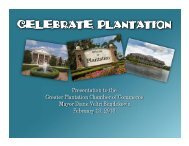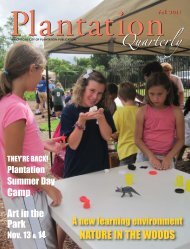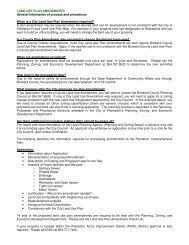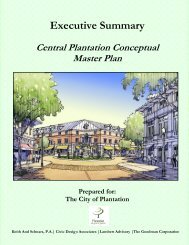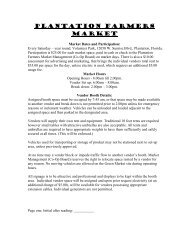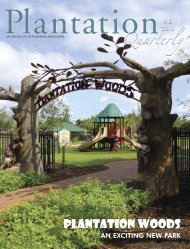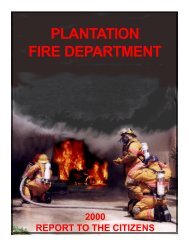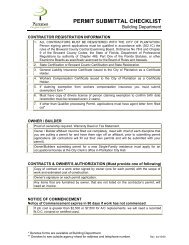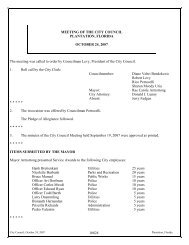pq fall pdf pages.qxp - City of Plantation
pq fall pdf pages.qxp - City of Plantation
pq fall pdf pages.qxp - City of Plantation
You also want an ePaper? Increase the reach of your titles
YUMPU automatically turns print PDFs into web optimized ePapers that Google loves.
COUNCILMAN<br />
EDWARDS RESIGNS<br />
The <strong>City</strong> <strong>of</strong> <strong>Plantation</strong> regretfully<br />
announces the resignation <strong>of</strong> Councilman<br />
Bruce Edwards from <strong>Plantation</strong> <strong>City</strong><br />
Council.<br />
Bruce Edwards was first elected to<br />
Council in 1997, and was recently<br />
reelected for a third term in March 2005.<br />
He is a <strong>Plantation</strong> native and is the first<br />
elected <strong>of</strong>ficial to be born in the <strong>City</strong>. In<br />
addition to being President <strong>of</strong> his familyowned<br />
and operated business,<br />
Councilman Edwards served on the<br />
Board <strong>of</strong> Trustees <strong>of</strong> <strong>Plantation</strong> General<br />
Hospital, is a past Chairman <strong>of</strong> the<br />
<strong>Plantation</strong> Police Retirement Board, and<br />
is a Trustee on the <strong>Plantation</strong> Volunteer<br />
Firefighter Retirement Board. He was the<br />
driving force behind bringing the<br />
Provider Pals program to two <strong>City</strong> schools<br />
and the <strong>City</strong>’s sponsorship and participation<br />
in several National Conference for<br />
Community Justice (NCCJ) programs and<br />
events.<br />
“Bruce Edwards was a valued, integral<br />
part <strong>of</strong> our team <strong>of</strong> elected <strong>of</strong>ficials,”<br />
stated Mayor Rae Carole Armstrong.<br />
“Throughout his three terms in <strong>of</strong>fice,<br />
Bruce was a strong supporter <strong>of</strong> a<br />
number <strong>of</strong> initiatives that will serve to<br />
promote <strong>Plantation</strong> in the years to come<br />
as a great place to live, work and play. He<br />
enthusiastically pushed for the <strong>Plantation</strong><br />
Equestrian Center and the acquisition and<br />
development <strong>of</strong> <strong>Plantation</strong> Preserve Golf<br />
Course & Club, and was supportive <strong>of</strong> our<br />
economic development initiatives, particularly<br />
in the Gateway area.”<br />
Mr. Edwards’ commitment to <strong>Plantation</strong><br />
was unwavering, and his decisions were<br />
based on what he believed would have<br />
the greatest positive effect on the needs <strong>of</strong><br />
<strong>Plantation</strong>’s residents, students and<br />
businesses. Throughout his terms, he has<br />
received numerous commendations and<br />
accolades from the public and his peers<br />
for his leadership and conviction. The<br />
<strong>City</strong> <strong>of</strong> <strong>Plantation</strong> wishes him the very<br />
best.<br />
A <strong>City</strong> <strong>of</strong> <strong>Plantation</strong> Special Election will<br />
be held on August 30 to fill this position.<br />
Don’t forget to VOTE!<br />
Plant <strong>of</strong> the Quarter<br />
SOUTHERN RED CEDAR (Juniperus virginiana silicicola)<br />
Patrice Sonnelitter, Associate Landscape Architect<br />
With the exception <strong>of</strong> the Bald Cypress, Taxodium dictichum, we haven’t talked about conifers (those<br />
plants that bear cones) in our Plant <strong>of</strong> the Quarter series. Conifers are an interesting group <strong>of</strong> plants<br />
characterized by needle-like or flat scale-like foliage. The<br />
foliage <strong>of</strong> the featured Plant <strong>of</strong> the Quarter, the<br />
Southern Red Cedar is scale-like (overlaps like the<br />
shingles on a ro<strong>of</strong>) and s<strong>of</strong>t to the touch. The<br />
Southern Red Cedar is a member <strong>of</strong> the<br />
Cupressaceae (Cypress) family. It is a native<br />
<strong>of</strong> the southeastern United States and a variety<br />
<strong>of</strong> the Eastern Red Cedar, whose wood is<br />
cherished for its use for cedar chests and<br />
aroma that keeps moths at bay. Silicicola<br />
refers to the Latin name meaning growing in<br />
sand. Junipers vary in their habit from low,<br />
sprawling and sharp to the touch to tall, conical and s<strong>of</strong>t to the touch. The Southern Red Cedar is a large<br />
Juniper with a large, loose, somewhat open conical shape that looks at home in an open natural<br />
landscape.<br />
A BRIEF SUMMARY OF THIS SPECIES:<br />
HABIT/ HEIGHT/ SPREAD The Southern<br />
Red Cedar can reach a magnificent stature <strong>of</strong> 50’<br />
but it is more likely will be found as a medium<br />
sized evergreen conifer reaching 25 to 30’. It has a<br />
feathery, fine texture and Christmas tree shape<br />
when young maturing to a more irregular conical<br />
shape with drooping upper branches. It width can<br />
easily match its height. Its density and shape are its<br />
most distinguishing features.<br />
FOLIAGE/ FLOWERS/ FRUIT Its evergreen,<br />
overlapping, scale-like leaves are 1/32 to 3/16<br />
inches long. They are arranged opposite and<br />
whorled along the branches. The foliage is fragrant<br />
and ranges in color from bluish-green to yellowgreen.<br />
In the winter separate sex plants<br />
(dioecious) produce inconspicuous flowers. Conelike<br />
male flowers are green. Female flowers are<br />
yellow-green which produce round, 1/5-inch<br />
powdery blue-green berries. The Southern red<br />
cedar is one <strong>of</strong> the most valuable trees for wildlife,<br />
which uses it as a major food source and shelter<br />
for birds.<br />
BARK AND WOOD The wood is reddish<br />
brown and peels in strips. The wood, as well as the<br />
foliage, is fragrant and repels insects.<br />
HORTICULTURE It is accepting <strong>of</strong> a wide<br />
range <strong>of</strong> soil types and pH ranges. It prefers dry,<br />
sandy soil (silicicola), full sun and well-drained<br />
soil. Once planted, it prefers not to be disturbed<br />
or transplanted. It is salt and drought tolerate<br />
and <strong>of</strong>ten seen as a volunteer in disturbed areas.<br />
Plant in a fertile area if possible and water until<br />
established.<br />
LANDSCAPE USE Because <strong>of</strong> its shape and<br />
density, it is more valuable for its screening ability<br />
than its ability to produce shade. It makes an<br />
excellent wind break or privacy hedge as tall<br />
hedges when planted in a staggered row. Set as a<br />
background tree it will make an excellent specimen<br />
plant. This plant could be placed on the perimeter<br />
<strong>of</strong> a medium to large sized lot. A number <strong>of</strong><br />
Southern Red Cedars are being planted on the<br />
<strong>Plantation</strong> Preserve Golf course to provide a<br />
naturalized look.<br />
PROBLEMS/ PEST Bagworms, spider mites,<br />
cedar-apple rust and Juniper blight.<br />
PURCHASING AND PLANTING When<br />
shopping for any tree, remember not to be tempted<br />
by a tree that does not demonstrate good branch<br />
structure or that has girdled roots (roots that<br />
encircle the root ball and run around the edge <strong>of</strong><br />
the container). Keep looking. Look for a straight,<br />
single trunk and evenly spaced branches around<br />
the whole tree. Always plant to expose the root<br />
flare. It is common with nursery grown plant<br />
material to have extra soil over the root ball. Before<br />
planting, carefully scrape away the excess soil and<br />
small surface roots until you expose a definite flare<br />
at the base. This is where you will find the beginnings<br />
<strong>of</strong> the true roots. Create an earthen ring<br />
about six-inch high and several feet from the trunk<br />
to retain extra water until the tree is established.<br />
Apply two to three inches <strong>of</strong> mulch to retain<br />
moisture, to discourage weed growth and to keep<br />
that nasty string trimmer that loves to bite into its<br />
tender bark. Don’t allow the mulch to touch the<br />
bark. The trunk does not do well with the extra<br />
moisture and the mulch encourages insects to<br />
nest there.<br />
12 <strong>Plantation</strong> Quarterly Fall 2005<br />
GOOD LUCK AND HAPPY BOTANIZING!



